Bethlehem
“For to you is born this day in the city of David a Savior, who is Christ the Lord.” (Luke 2:11)
SCRIPTURE: Bethlehem is important in the Old Testament, in the history of the Israelites, both before they enter Egypt and slavery, and after the Exodus. It appears in the Old Testament as Ephrath, which was near the place where Rachel, the favorite wife of Jacob, died in childbirth giving birth to Benjamin (Gen. 48:7). Over her tomb, Jacob set up a pillar in her memory. The tomb of Rachel was on display in the time of Jesus and, to this day, it is still visited. According to the Book of Ruth, the valley to the east is where Ruth of Moab gleaned the fields and returned to town with Naomi. Ruth and Boaz gave birth to “Obed; he was of the father of Jesse, the father of David” (Ruth 4:17), who was anointed as King by the prophet Samuel (I Samuel 17:12). It is from this lineage that Jesus is born (Mt 1:5-6; Lk 3:32).
In the Book of Micah, we read the prophecy concerning Jesus: “But you, O Bethlehem Ephrathah, who are little to be among the clans of Judah, from you shall come forth for me one who is to be ruler in Israel, whose origin is from of old, from ancient days” (5:2). According to Matthew 2 and Luke 2, Jesus was born in Bethlehem, and Matthew interpreted this as the fulfillment of Micah’s prophecy.
When the Magi came searching for the newborn King, Herod knew where to look for him, for it had been revealed centuries earlier by Micah. Jeremiah had predicted Herod’s murder of the children in Bethlehem: “Thus says the Lord: ‘A voice is heard in Ramah, lamentation and bitter weeping. Rachel is weeping for her children; she refuses to be comforted for her children, because they are no more’” (31:15). When seen in the light of the birth of Jesus, our sadness is consoled when we read in Micah that He will bring peace (5:5).
BETHLEHEM means “House of Bread” (from the Hebrew) or “House of Meat” (from the Arabic) and is located about six miles south of Jerusalem.

(photo: Maps Jerusalem)
Ordinarily during the Christmas season, hosts of Christians make a pilgrimage to the important holy site of the Church of the Nativity which is built over the cave where Mary gave birth to Jesus. At the far end of the church square is the entrance to the church known as the “Crusader Doorway.” It was lowered in 1500 AD in order to stop Muslims riding their horses inside the church and to prevent looters access with their carts. Now all visitors have to bow down to go through the “Door of Humility” because it is the only doorway in the fortress-like front wall and measures 4 feet high. To us Christians, it seems appropriate to bend our head and knees before entering the place where God humbled himself to become man.
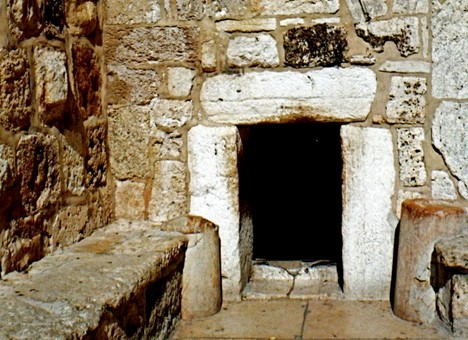
(photo: seetheholyland.net: only entrance to the Church of the Nativity)
Let us look at the Church of the Nativity. The basilica that we see today is the oldest complete (i.e., not in partial ruins) church in the world. It was built by the emperor Justinian in the 6th century. It replaced the original church of Constantine and his mother, Saint Helena. In the year 326, Helena began a pilgrimage to the Holy Land, and on her arrival, she ordered the construction of a basilica over the Cave of the Nativity in Bethlehem.
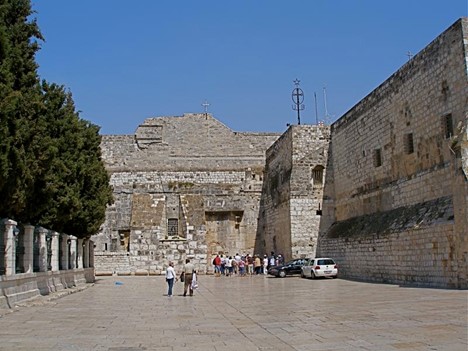
(photo: seetheholyland.net: Church of the Nativity)
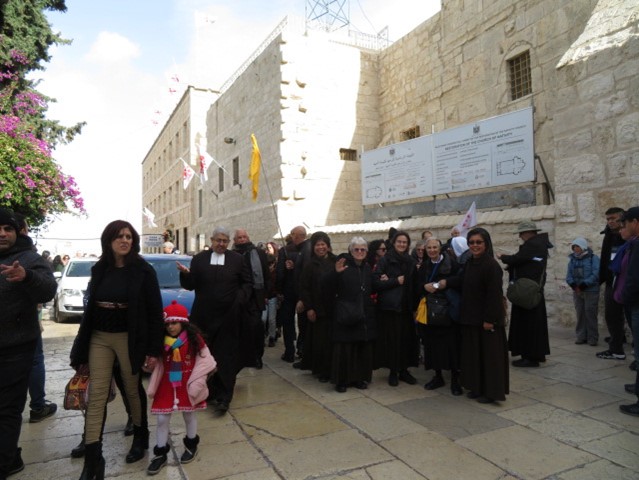
(photo: SMRP: Church of the Nativity and the Franciscan Sisters of the Eucharist)
Now the Gospels do not say that Jesus was born in a cave, but there are written references to the Nativity cave as far back as 160 AD. Furthermore, we can be sure of the historical reliability that this was the location of Christ’s birthplace since it was the custom of the Roman emperor Hadrian (117-138 AD) to build pagan sanctuaries on top of places that were considered important for Jewish and Christian worship and veneration. And this is what he did here in Bethlehem. He constructed a grove to the god Tammuz-Adonis and a temple to Venus over the grotto of the Nativity. Origen of Alexandria (185-c.254), an early Christian theologian, visited this pagan cult place in 220 AD. He wrote that “the heathens themselves tell everyone who is willing to listen that in the said grotto, there was born a certain Jesus, whom the Christians revered” (Contra Celsum 1.51).
Is it not ironical that the key evidence for identifying Christian holy sites is owed to the emperor’s attempted destruction and paganizing of those sites? This is God’s providence at work.
With the site identified by Helena, the first Church of the Nativity was built by Constantine and dedicated on May 31, 339. There are three major architectural sections: an apse in a polygonal shape, encircling a raised platform with an opening in its floor that allowed a direct view of the Nativity site below; a five aisled basilica like the basilicas in Rome; and an atrium with a portico. As mentioned, the apse of this church was situated directly above the cave of the Nativity. The cave was reached by a set of stairs. The only visible elements of the Constantinian church today are segments of a mosaic floor.
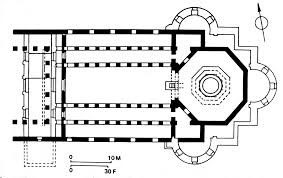 plan ca. 333 AD (photo: commons.wikipedia.org)
plan ca. 333 AD (photo: commons.wikipedia.org)
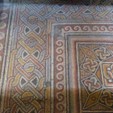
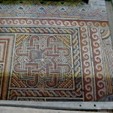
(photos: seetheholyland.net: mosaic floor)
The grotto of the Nativity is dimly lit. It contains an altar, and the exact spot where Jesus was born is marked beneath this altar by a 14-point silver star on the marble floor. It bears the Latin words: “Hic de Virgine Maria Jesus Christus Natus est” which means: “Here Jesus Christ was born of the Virgin Mary.” The 14 points on the star represent the three sets of 14 generations in the genealogy of Jesus Christ: 14 generations from Abraham to David; 14 generations from David to the Babylonian captivity; and 14 generations more to Jesus Christ. The cave measures about 40 feet x 10 feet.
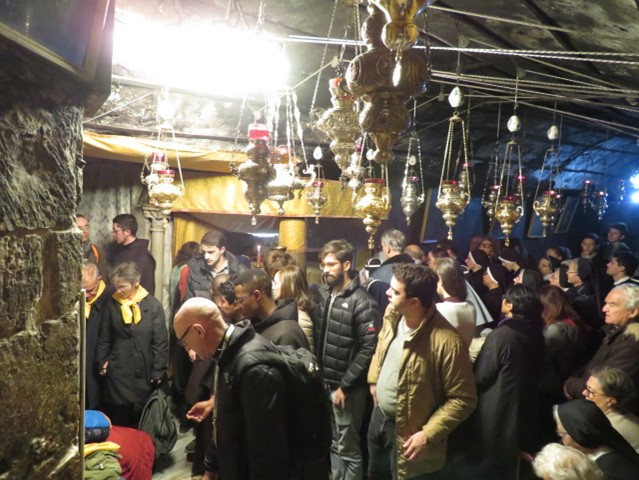
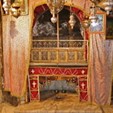
(left photo: SMRP: grotto of the Nativity) (right photo: seetheholyland.net:grotto)

(photo: Catholic World Report: 14-point silver star)
In 384 St. Jerome began living in Bethlehem, and two years later, he was joined by Paula and her daughter, Eustochium. Paula was a wealthy Roman widow who founded two monasteries, one for herself and her nuns and one for Jerome and his monks. Both Paula and her daughter lived saintly lives and worked with Jerome to make Bethlehem a great monastic center. Jerome studied the Bible and the ancient languages. He made a new translation of the Old Testament, the Vulgate, and improved the Old Latin version of the New Testament. He attests to the existence of caves near the main cave. In one of them, he buried St. Paula in 404, and in another, he himself wanted to be buried, so that he could be near the place where Jesus was born. He was, in fact, buried in the nearby cave in 420, but centuries later, his remains were transferred to the Basilica of Santa Maria Maggiore in Rome. When St. Eustochium died in 417, she was buried in the same cave as her mother.
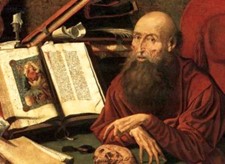
(photo: Wikipedia: detail of St. Jerome by Maurinus van Reymerswaele, ca. 1490-ca.1546)
In 529, the emperor Justinian pulled down the Constantinian church, damaged by the Samaritan revolts, and built up a magnificent edifice which remains in use today. The façade was once decorated with a representation of the three Magi from Persia. In 614, Persian invaders destroyed almost all the sanctuaries of the Holy Land, except this one. When they came to Bethlehem, and saw the Magi depicted on the front of the church, they decided, out of respect for their ancestors, to honor these sages by sparing the church.

(photo: Qantara.de: The Justinian Church of the Nativity today)
Again the church was in danger, when some 200 years later, the country was overrun by Islamic Arabs. But their leader, Omar, did the unexpected. He decided that the place where their prophet Issa (Jesus) was born of the Virgin Mariam (Mary) should be protected. He knelt down in the southern apse of the church to pray to Mecca. His prayerful action prompted followers of Islam to preserve the church as a site holy in the history of Islam.
The basilica is now mostly Greek Orthodox. The Armenian Orthodox own the northern transept. The Catholics take care of the site of the manger and the adjoining altar next to the Nativity grotto.
Catholic services for Christmas take place in the Church of St. Catherine, adjacent to the Church of the Nativity. They begin on Christmas Eve, December 24th and continue on Christmas day, December 25th, according to the Gregorian calendar.
The Orthodox celebrate Christmas on January 7th, using the old Julian calendar. The Armenians celebrate Jesus’ birth and His baptism together on January 19.
To the left of the Church of the Nativity, is the Latin Rite Church of St. Catherine of Alexandria, served by the Franciscans. It is the parish church for Bethlehem’s Catholics, and it is here that the Latin Patriarch of Jerusalem, celebrates the Vigil Mass of Christmas. On October 24, 2020, Pierbattista Pizzaballa, an Italian Franciscan friar and head (custos) of the Franciscan priory known as the Custody of the Holy Land, was named by Pope Francis as the Latin Patriarch of Jerusalem. He had been the Apostolic Administrator of the Patriarchate since 2016, so he was the one who celebrated Christmas Day Mass for us pilgrims (Sister Maria Socorro, MCMI and Sister M. Regina Pacis, FSGM and fellow pilgrims) in 2019.
Inside to the right near the front of the church, we can descend stairs that grant access to the various caves which are close to the principal grotto in the main church.
In front of the Church of St. Catherine is a statue of St. Jerome. At his feet is a skull, a symbol of the transience of human existence.

(photo: aleteia.org: Latin Rite Church of St. Catherine of Alexandria)
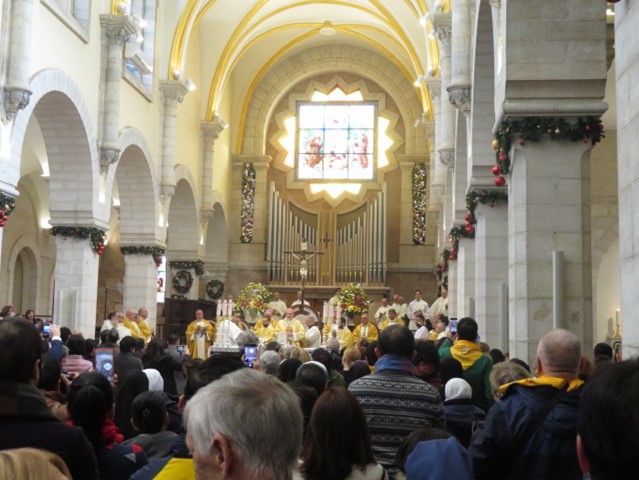
(photo: SMRP: interior of the Church of St. Catherine of Alexandria)
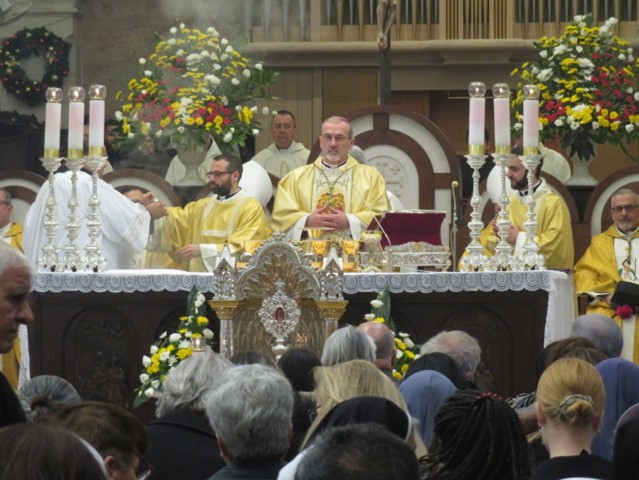
(photo: SMRP: Newly named Latin Patriarch Pizzaballa celebrating Christmas Mass in the Church of St. Catherine of Alexandria)
Who is St. Catherine of Alexandria? According to tradition, she was an early 4th century martyr from Egypt. She became a Christian at the age of 14, converted many people to Christianity, and was martyred at the age of 18. From a young age she devoted herself to study. When persecutions began under the emperor Maxentius, she went to the emperor and challenged him for persecuting the Christians. The emperor summoned 50 philosophers and orators to debate with her, hoping that they would refute her pro-Christian arguments, but Catherine won the debate. Her adversaries, won over by her words, declared themselves Christians and were immediately put to death. Catherine herself was scourged and put in prison. Finally, the emperor, unable to make Catherine yield by means of torture, condemned her to death on a spiked wheel, but when she touched the wheel it shattered. Maxentius then ordered her to be beheaded. In the 6th century the emperor Justinian built a church and monastery dedicated to the Transfiguration of Christ, but now it is called St. Catherine’s Monastery. Many pilgrims come to that monastery to receive miraculous healings from Catherine. Her feast day is November 25th. St. Joan of Arc identified her as one of the saints who appeared and spoke to her during her trial and gave her counsel.

(photo: catholic.org: St. Catherine)
POINTS OF REFLECTION
*I am attaching here an extract from Bariona or the son of thunder by Jean Paul Sartre. Now Sartre was an existential atheist. But when I first read this passage in the 1980s, I could not believe that Jean Paul Sartre was really an atheist. Not surprisingly, I learned later that he died a believer. For a time during World War II, he was a prisoner of the Nazis. In this setting, he and some fellow prisoners discussed in turn how each one would paint Mary and Jesus, if he were a painter:
“The Virgin is pale and looking at the child. What should be painted on her face is an anxious amazement that has only appeared once on a human face. Because the Christ is her child, flesh of her flesh, it is the fruit of her womb. She has carried him nine months and she will give him her breast and her milk will become the blood of God. And at certain moments the temptation is so strong that she forgets he is God. She hugs him in her arms and says: my little one! But in other moments, she is speechless and thinks: God is there and she feels gripped by a religious horror for this mute God, for this terrifying child. For all mothers are in this way attracted at moments before this rebellious fragment of their flesh that is their child and they feel outcast before this new life that has been made of their life and that they populate with foreign thoughts. But no child has been more cruelly and more quickly torn from his mother, for he is God and is beyond everything that she can imagine…. But I think there are also other moments, swift and difficult, in which she feels at the same moment that the Christ is her son, and that he is God. She looks at him and thinks: «This God is my son. This divine flesh is my flesh. He is made of me, he has my eyes and the shape of his mouth is the shape of mine. He looks like me. He is God and he looks like me». And no woman has had in lot her God to herself alone. A little God that one can take in one’s arms and cover with kisses, a warm God that smiles and breathes, a God that one can touch and that lives. And it is in those moments that I would paint Mary, if I were a painter, and I would try to render the expression of tender boldness and timidity with which she reaches out her finger to touch the sweet small skin of this Child-God whose warm weight she feels in her lap and who smiles at her… (Published in the monthly magazine 30 Days issue no. 01-2004; published for the first time in Italian by Christian Mariotti Edizioni.)
*I suggest reading the Christmas Vigil Mass homily of 2006 by Pope Emeritus Benedict XVI.
*We cannot forget St. Joseph. The following is an excerpt from Pope Francis’ latest Apostolic Letter: Patris corde, on the occasion of the 150th Anniversary of the Declaration of St. Joseph as the Patron of the Universal Church:
“Joseph found happiness not in mere self-sacrifice but in self-gift. In him, we never see frustration but only trust. His patient silence was the prelude to concrete expressions of trust. Our world today needs fathers. It has no use for tyrants who would domineer others as a means of compensating for their own needs. It rejects those who confuse authority with authoritarianism, service with servility, discussion with oppression, charity with a welfare mentality, power with destruction. Every true vocation is born of the gift of oneself, which is the fruit of mature sacrifice. The priesthood and consecrated life likewise require this kind of maturity. Whatever our vocation, whether to marriage, celibacy or virginity, our gift of self will not come to fulfillment if it stops at sacrifice; were that the case, instead of becoming a sign of the beauty and joy of love, the gift of self would risk being an expression of unhappiness, sadness and frustration.”
Pope Francis ends his letter with this prayer:
Hail, Guardian of the Redeemer,
Spouse of the Blessed Virgin Mary.
To you God entrusted his only Son;
in you Mary placed her trust;
with you Christ became man.
Blessed Joseph, to us too,
show yourself a father
and guide us in the path of life.
Obtain for us grace, mercy and courage,
and defend us from every evil. Amen.
Now, we too, come to an end; the end, that is, of our pilgrimage to the little towns of Nazareth, Ain Karem and Bethlehem. Merry Christmas!
